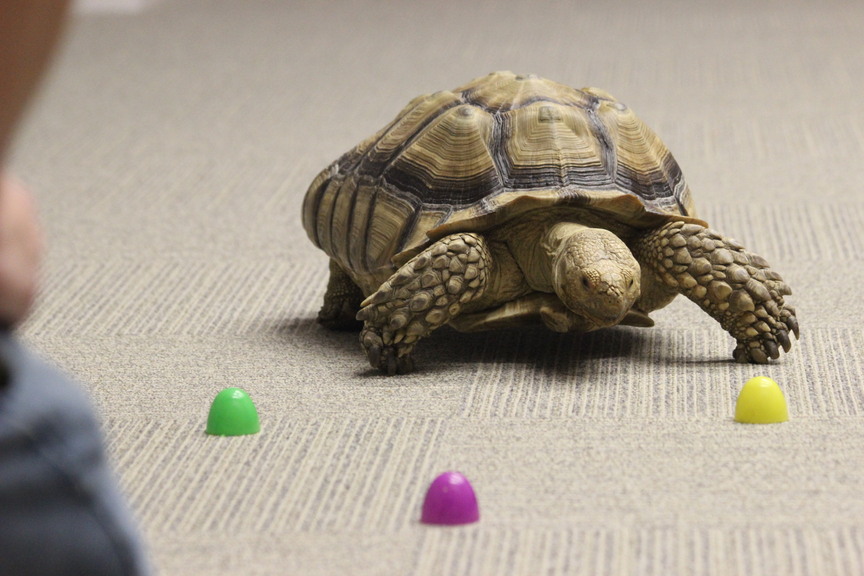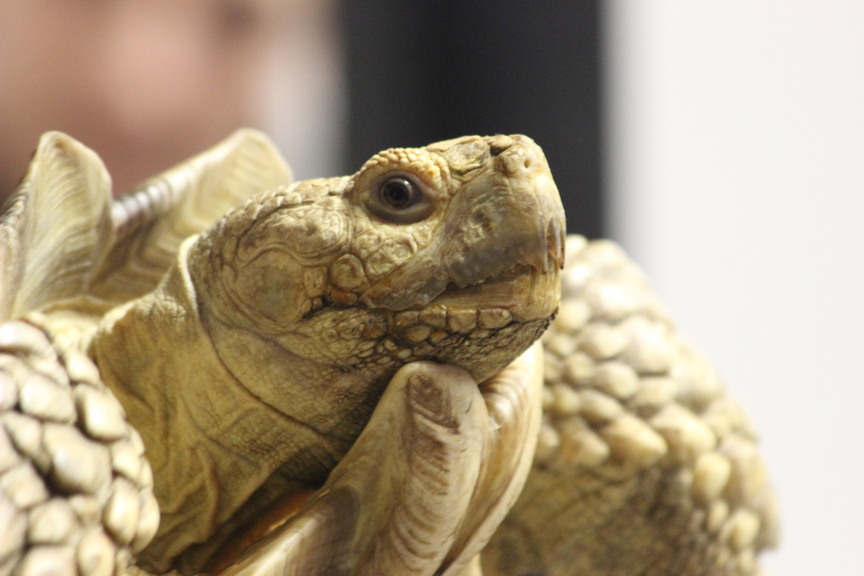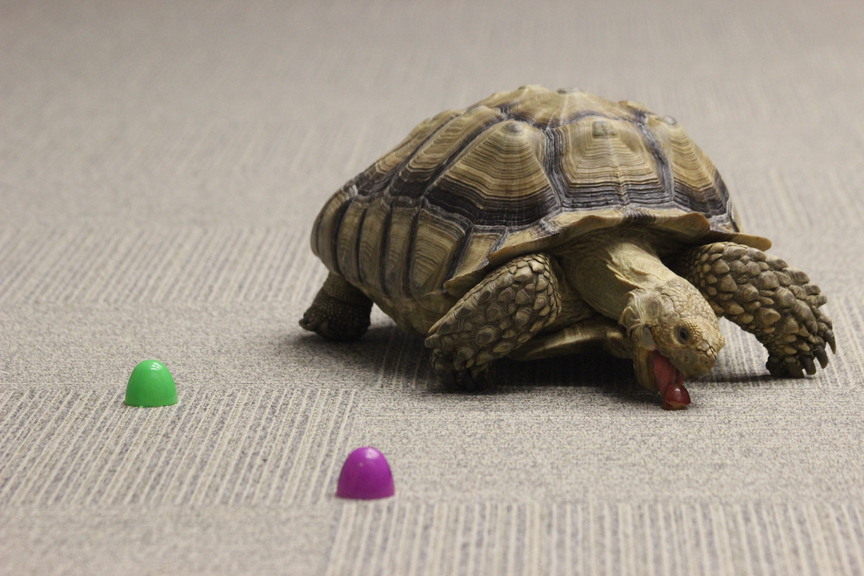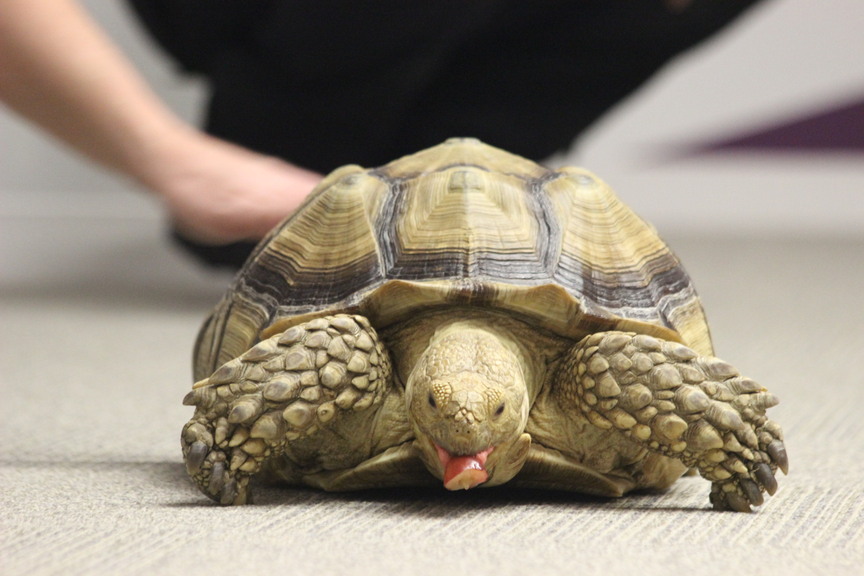
While he may not be as ancient as some of the critters on display, one local reptile has become a star attraction at the Philip J. Currie Dinosaur Museum.
On Saturday, the museum held a celebration (or shell-a-bration) to mark the one-year anniversary of the adoption of Mack, an African spurred tortoise. In his year with the museum, he has become a beloved celebrity, from visiting tourists to dining firefighters.
Amidst the celebrations, education and exhibit co-ordinator Jessy Dion sat down with the News to talk about Mack’s life story.

While Mack’s species is a native of Africa in the northern region of the Sahara Desert, Mack himself is Quebecois, having been seized from a Quebec apartment with 10 other tortoises.
After spending some time in wildlife refuges, Mack was listed online for sale as his then-home needed the funds to rescue 20 parrots.
And this is when the Philip J. Currie Dinosaur Museum – and Dion himself – discovered Mack.
“It was my fault,” Dion remembered.
“I was going through some older proposals, and one of them was to get a tortoise. People are focused on dinosaurs because they’re so amazing, but we wanted to bring awareness that there were other living creatures that were at the time of the dinosaurs.
“At the time we already had two geckos and a snake, and a tortoise would be fun to have.”
Dion planned to get a small marginated tortoise, a species which only grows up to 25 cm. long at full growth.
But on the day Dion planned to head to Calgary to pick up the tortoise he had arranged to buy, he received news the reptile had already been sold.
“I was pretty upset, and I went on the internet and I rage wrote, ‘largest tortoise for sale in Canada,’ and this guy appeared!” Dion said.
By buying Mack, Dion was happy to report that the refuge was able to provide the care for 20 parrots.
“They needed a quick income and the government unfortunately didn’t provide much help,” he said.
“They needed some money to help those parrots, so they had to let go of Mack; so we wound up helping some dinosaurs, I guess.”

While African spurred tortoises can live to over 100 years old in captivity, Mack is a spring chicken when it comes to tortoises.
“Before we got him, it was mentioned that he was 22 years old,” Dion remembered.
“When he arrived at the airport, we realized that he was very, very small for 22 years old; checking the overall length of the shell and comparing with his overall mass, it was putting him in the seven- to 10-year-old age range.”
When Mack first arrvied, Dion said he was a shy little critter.
“He was cautious for the first two weeks so it was hard to approach his head or his front in general, because would always retract.
“Now he lets me scratch his neck so he has adapted really well.”
Dion said Mack has been flourishing here.
“He hasn't been able to tell us, but it’s very dry in Alberta, very comparable to his species' needs,” Dion said.
“In Quebec it was a little more humid and he did arrive with some shell rot. It’s not uncommon, but we’ve seen some good healing on it and so I think he likes the dry environment.”
Mack has been living a life of luxury, eating hay and the occasional treat of a lettuce leaf or a grape.
“He’s a prince, so he needs his hay to be wet,” Dion said.
“When you see he’s not eating his hay, you spray it with water and then he starts eating again.”
In summer, he takes an escapade outside, enjoying the hot, dry weather and exercising three days a week.
It’s quite a change from his life in a small town in Quebec, where he didn’t have the chance to go outside.
“Here we have people that, during the summer, take time to bring him outside,” Dion said.
“He munches on vegetation, and also he can touch the real ground. It’s good for him for enrichment.”
In the winter, he wanders about the theatre and parts of the museum gallery.

Over the past year, students and visitors have come to love Mack, with his biggest fans being the Wembley Fire Department.
“They always go to the cafe here for lunch, and they come and say hi to Mack,” Dion said.
“We kind of joke that he’s more the mascot of the fire department than the museum. They really love Mack, but he’s really popular with kids and older people as well.”
And there’s just going to be more of Mack to love in the future. As he grows, Dion said they anticipate he will double - possibly triple - his current weight of 15 kg. as adult males of his ilk can grow to just shy of 90 kg.
“They’re nicknamed ‘walking coffee tables,’” Dion said.
“They’re the third largest tortoises in the world; the first is the Galapagos tortoise, and then we have the Aldabra giant tortoise from the Indian Ocean.
“We want to designate a portion of a room for him. We would like to have him on the ground in the fertile ground with a good substrate for him to dig a little bit.”
As it is, Mack will continue to be the star of the museum, with the same determination that carried turtles through ancient times to the modern day.
“Turtles were around during the times of the dinosaurs,” Dion said.
“They made it through these extinctions with some adjustments, but they’re the ones that just pushed through. And that’s the mentality of tortoises just to blow through the obstacles.
“He helps us bring awareness and also brings some joy here.”